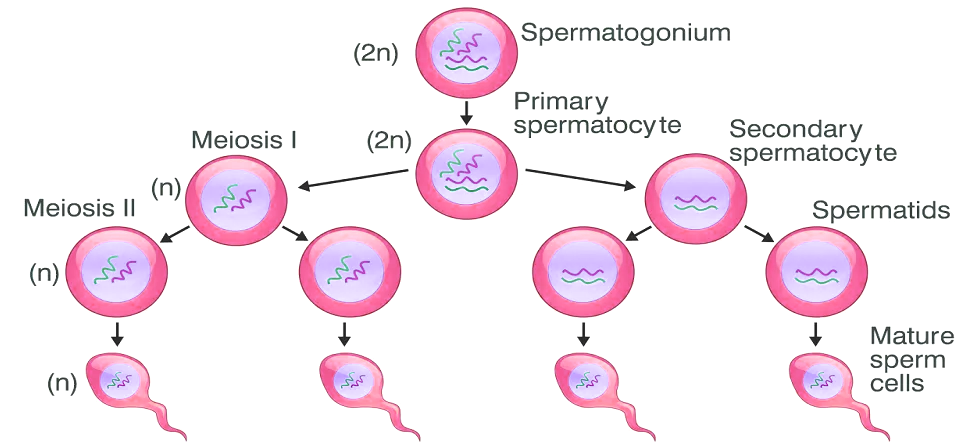
Answer
467.1k+ views
Hint: In this process, the spermatogonial cells function as the stem cells that are found in the basement membrane of the seminiferous tubules.
Complete answer: Spermatogenesis is the process of formation of sperms and it occurs in the male gonads testes that are made up of many seminiferous tubules lined by germinal epithelium. Spermatozoa are formed by the division of these cells in the following manner –
1. Multiplication Phase – This is the first phase and in this phase, the mature primordial germ cells divide by mitosis to produce a large number of spermatogonia.
2. Growth Phase – During this phase, the spermatogonium grows to a primary spermatocyte while obtaining nourishment from the nursing cells present in the testes.
3. Maturation Phase – In this phase, each primary spermatocyte undergoes two maturation divisions out of which the first one is reductional where two haploid daughter cells are formed that are called secondary spermatocytes. The second maturation division occurs in both secondary spermatocytes and four haploid spermatids are formed.
4.Spermiogenesis – This is the final step of spermatogenesis where the process of transformation of spermatid to a spermatozoon occurs. The spermatozoa thus formed are known as sperms.
Note: At all stages mentioned above, the spermatogenic cells are in close contact with Sertoli cells. These cells provide structural and metabolic support to the developing sperm cells and are also known as the ‘nurse cells’. They perform many supportive functions like maintaining the necessary environment, secreting a required hormone, protecting spermatids, etc.

Complete answer: Spermatogenesis is the process of formation of sperms and it occurs in the male gonads testes that are made up of many seminiferous tubules lined by germinal epithelium. Spermatozoa are formed by the division of these cells in the following manner –
1. Multiplication Phase – This is the first phase and in this phase, the mature primordial germ cells divide by mitosis to produce a large number of spermatogonia.
2. Growth Phase – During this phase, the spermatogonium grows to a primary spermatocyte while obtaining nourishment from the nursing cells present in the testes.
3. Maturation Phase – In this phase, each primary spermatocyte undergoes two maturation divisions out of which the first one is reductional where two haploid daughter cells are formed that are called secondary spermatocytes. The second maturation division occurs in both secondary spermatocytes and four haploid spermatids are formed.
4.Spermiogenesis – This is the final step of spermatogenesis where the process of transformation of spermatid to a spermatozoon occurs. The spermatozoa thus formed are known as sperms.
Note: At all stages mentioned above, the spermatogenic cells are in close contact with Sertoli cells. These cells provide structural and metabolic support to the developing sperm cells and are also known as the ‘nurse cells’. They perform many supportive functions like maintaining the necessary environment, secreting a required hormone, protecting spermatids, etc.

Recently Updated Pages
Identify the feminine gender noun from the given sentence class 10 english CBSE

Your club organized a blood donation camp in your city class 10 english CBSE

Choose the correct meaning of the idiomphrase from class 10 english CBSE

Identify the neuter gender noun from the given sentence class 10 english CBSE

Choose the word which best expresses the meaning of class 10 english CBSE

Choose the word which is closest to the opposite in class 10 english CBSE

Trending doubts
How do you graph the function fx 4x class 9 maths CBSE

Fill the blanks with the suitable prepositions 1 The class 9 english CBSE

Which are the Top 10 Largest Countries of the World?

A rainbow has circular shape because A The earth is class 11 physics CBSE

Change the following sentences into negative and interrogative class 10 english CBSE

The Equation xxx + 2 is Satisfied when x is Equal to Class 10 Maths

Give 10 examples for herbs , shrubs , climbers , creepers

Difference between Prokaryotic cell and Eukaryotic class 11 biology CBSE

One Metric ton is equal to kg A 10000 B 1000 C 100 class 11 physics CBSE




